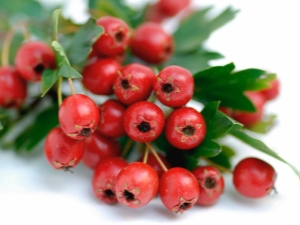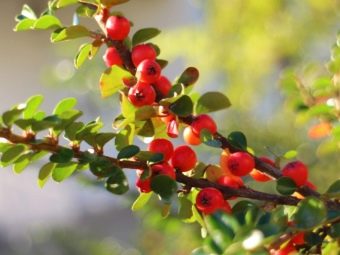What heart disease does hawthorn cure?

The frequency of cardiovascular diseases is so high that it is comparable in scale with the epidemic. Early detection and treatment of cardiac pathologies at an early stage are extremely important, and phytotherapy can provide invaluable help at this stage. The benefits of treatment with plants are quite significant - this is biological affinity with the human body, and multidirectional action, because in one plant sometimes contains several active substances that can affect different parts of the disease.
Among the plants with a century of experience in using heart diseases recognized by cardiologists, one of the leading places belongs to hawthorn.
Distribution and description
It is noteworthy that at first hawthorn was used as a fastening agent for digestive disorders and only much later it was determined that it can be extremely useful for the treatment of diseases of the heart and blood vessels. These valuable properties are found in the leaves and flowers, as well as in the fruits of the plant.
The great advantage of hawthorn is the availability of medicinal raw materials, because this shrub is spread throughout the northern hemisphere (excluding tundra and desert), undemanding and very resistant to drought or frost.
Hawthorn loves sparse forests, woods and meadows, often forms thickets on the banks of rivers. According to various sources, there are more than a thousand species of this plant, but in medicine the common hawthorn (prickly), blood-red, Dahurian, one-pest, five-pest and other species are most applicable.
In most species of hawthorn thorny shoots with large toothed leaves with short petioles. White flowers, collected inflorescences in the form of a shield, appear in late May or early June. Fruits ripen in September and look like small apples (less than one centimeter in diameter) with one or more hard stones inside. The color of the fruit, depending on the type, can be from orange and red to almost black.
Stocking
Hawthorn leaves are harvested with flowers in the period of their blooming, because it is then that they contain the largest number of active substances. It will be right to collect these parts of the plant in dry weather in the morning after the dew subsides. For drying, the raw materials are scattered in a thin layer, sheltered from the sun, in well ventilated areas. Fruits are harvested in September fully ripe.
At home, they can be dried in the oven. The optimum temperature for drying is 70 - 90 degrees.
Composition and properties of active substances
In hawthorn there are many vitamins that are beneficial for humans (A, C, B4, K, E) and trace elements. Its fruits are rich in pectins that can absorb and remove various toxins from the body. Nature seems to have specially collected a whole range of chemical components in this plant, endowing it with properties capable of bringing considerable benefits in cardiovascular diseases.
The composition of hawthorn included.
- Coumarins - these compounds have the ability to reduce blood clotting.
- Flavonoids: viferon, quercetin, hyperoside (which is especially abundant in hawthorn colors). In addition to antioxidant properties, the ability to maintain elasticity and enhance the strength of blood vessels, these compounds, especially hyperoside, are able to restore cardiac activity, stimulating the work of the myocardium. In addition, hyperoside acts as a sedative, reducing anxiety.
- Acetylcholine helps to reduce the frequency of contractions of the heart and contributes to the expansion of blood vessels.
- Choline (Vitamin B4) - This substance normalizes fat metabolism and improves metabolic processes in the nervous tissue, protecting nerve cells from damage.It restores damaged liver cells, while improving its work, cleans blood vessels, preventing the formation of cholesterol plaques and reducing the risk of developing cardiovascular pathologies. Choline is one of the factors that strengthen the myocardium and normalize heart rhythm.
- Catechins - the strongest antioxidants that prevent cells from collapsing from exposure to toxins. This, in turn, prevents the emergence of many diseases, such as hypertension, atherosclerosis, and diabetes.
- Ursolic acid reduces muscle wasting and stimulates their growth. It affects cholesterol and prevents atherosclerosis, has anti-inflammatory, antimicrobial action and strengthens the immune system.
- Oleanolic acid, in addition to hepatoprotective and antiviral effects, it blocks inflammation, relieves vascular spasm, reduces cholesterol levels and normalizes heart rate. It has a tonic effect on the nervous system, increases mental performance and stress resistance.
- Phytosterols able to reduce cholesterol and glucose in the bloodstream. In addition, they exhibit oncoprotective, hepatoprotective, antioxidant and immunomodulating abilities.
Useful qualities of hawthorn
Thus, hawthorn is able to exhibit properties that are very valuable for the successful treatment of heart disease, namely:
- to expand the blood vessels, helping to lower blood pressure;
- increase the blood flow in the coronary vessels, thus providing the heart with food and the supply of sufficient oxygen to this organ;
- show antiarrhythmic action, restoring normal heartbeat;
- reduce the excitability of the heart muscle, which, in turn, leads to an increase in its contractions,
- remove spasm and pain in the heart,
- normalize cholesterol and blood density, which is important for the prevention of heart attacks and strokes;
- have a sedative effect, eliminating nervous overexcitement and stress, improving the quality of sleep.
Use of hawthorn in cardiology
The fruits of the plant, its flowers and leaves will serve as a valuable natural addition to the basic treatment of such diseases:
- ischemic heart disease (angina);
- arrhythmias (paroxysmal, atrial), tachycardia (heart palpitations);
- atherosclerosis;
- cardiac neurosis, neurocircular dystonia;
- myocardial infarction (in the recovery process);
- hypertension;
- heart failure (initial stage).
In addition to the above diseases, hawthorn will help with diabetes, kidney disease, liver and gall bladder. Hawthorn will be useful for problems with digestion caused by pancreatitis or gastritis, diarrhea and abdominal pain.
The sedative properties of this plant will be useful in the treatment of epilepsy and various neuroses, as well as insomnia.
How to cook and consume hawthorn?
If you have failed to prepare hawthorn by yourself, you can purchase quality certified raw materials (fruits, leaves with flowers) at the pharmacy. The form of release or in filter packages, or in bulk in boxes. From the fruit is prepared decoction, and from flowers or leaves - tea or infusion. The healing effect will be enhanced if both leaves and flowers are used to prepare it. Basic recipes for these drinks are simple.
Tea
One bag of leaves with hawthorn flowers or a couple of teaspoons of this mixture out of the box, pour a cup of boiling water and stand under the lid for 15 minutes. Healthy drink is ready. Drink it a cup 2-3 times a day before meals.
Infusion
Pour a tablespoon of dry mixture of leaves and flowers into an enamel container, add 200 ml of boiled water, then cover with a lid and let it sit for 15 minutes. in a water bath. The infusion is cooled for 45 minutes. At this time, all useful components are extracted from the raw materials.Infusion filter and take a third cup 3 times a day before meals.
Decoction
Place a tablespoon of hawthorn berries into enameled dishes (if crushed, you can take two dessert spoons), add 200 ml of hot boiled water, close tightly and hold for 30 minutes in a boiling water bath to extract the active substances from they will need more time). After this, the broth is insisted for 10 minutes, filtered and drunk a third of a glass before breakfast, lunch and dinner.
When violations of the functional work of the cardiovascular system, accompanied by pain in the heart, increased pressure, agitation, anxiety, poor sleep and palpitations, it is good to use combinations of hawthorn with other plants. Motherwort, valerian, mint, lemon balm, peony and other plants will complement and enhance the therapeutic effect many times.
In addition to berries, flowers and leaves, as well as alcoholic tincture of hawthorn, in pharmacies you can find a lot of drugs with this plant as part (Trikardin, CardioActive Hawthorn Evalar, Kralonin, various herbal teas, etc.) The advantages of such herbal medicines in simple cases are obvious - this is a minimum of contraindications and side effects, the impact on different parts of the disease at the same time and the possibility of using it without a prescription (they are OTC).
Who will benefit hawthorn?
For older people, hawthorn is especially necessary, since this category of the population often has coronary insufficiency and a decrease in myocardial tone, causing malfunctions of the heart, and the need to prevent heart attacks and strokes increases. If hawthorn tincture is taken, if you take it 20-25 drops three times a day, it will help to normalize pressure and heart rate, relieve pain, shortness of breath and improve the condition of the blood vessels and heart function.
At a young and mature age, on the contrary, the risk of cardiovascular diseases increases from frequent stress, nervous and physical overload. This can be avoided by streamlining the regime, and herbal preparations with hawthorn will help to relieve tension and get rid of insomnia and headache, and improve overall well-being.
For women, hawthorn is indicated in the event of a violation of the cycle and during neuroses during menopause. Tea made from flowers and leaves will relieve nervous tension and anxiety, calm the heartbeat and pain, normalize sleep.
Contraindications and features of use
Despite the fact that hawthorn is very easily tolerated, there are still some moments when its reception is not recommended:
- intolerance that can occur individually;
- low pressure (hawthorn can aggravate the problem even more);
- slow heartbeat (bradycardia);
- women expecting a baby and breastfeeding;
- children's age (strictly prescribed by a doctor).
It is important to know that some people may experience drowsiness after taking hawthorn, and this should be taken into account in all cases that require concentration and concentration (driving, working with potentially dangerous machinery).
Abuse of hawthorn preparations, non-compliance with doses and the regimen of administration can lead to a critical decrease in blood pressure, bradycardia and serious consequences. This is the case when the drug can be harmful.
Meanwhile, the correct reception of this beautiful natural cardiotonics will bring your heart and nerves in perfect shape, improve your well-being and quality of life.
To learn how to prepare hawthorn tincture, see the next video.













































